My experience in India in 1994 was psychologically and physically akin to a battle in war. After suffering an acute debilitating form of dysentery alone on the streets of New Delhi, on the emergency flight home to New York I had a Near Death Experience. Upon return from that heavenly light, my illness miraculously vanished. I could not make sense of what happened to me, nor of the profound truths and blissful visions I had received. I realized that I was alone in this experience and this aloneness would last forever. Four days after my return to New York City, I had a mental breakdown from the trauma and landed in St. Vincent’s Hospital in Harrison, New York.
Without any evidence of my illness in India—no signs of the dehydration, abdominal agony, or violent and continuous vomiting and excretions I had suffered for days on end—my story held little credulity with the doctors and was seen as delusional. After the long run of evaluations and two weeks in their asylum, the verdict came in. The medical team finally figured out what was wrong with me. I was, in fact, “mentally ill.” This “bipolar disorder”—a chronic condition categorized by dramatic shifts in mood—would be with me for the rest of my life, they said, since it was a genetic, pathological illness with no cure. The doctors casually prescribed to me a treatment plan of lifelong brain medication supplemented with an indeterminate, ongoing regimen of weekly therapy, while they entirely ignored my trauma in India.
For years I despised ingesting the toxic antipsychotics forced down my throat so that I could be “normal” like everyone else. I received my first chemical lobotomy from Haldol. It emotionally tranquilized me, creating a black heaviness around my thoughts, making it impossible for me to read or express my ideas verbally. Then there was Risperdal, which wrapped my personality in a straitjacket and offered the attractive “side effects” of slurred speech and restlessness. And Meleril gifted me dry mouth, uncontrollable strange ticks, memory loss, and the chronic fatigue of a 90-year-old woman. When I finally moved onto lithium (one of the main anti-manic drugs used to treat bipolar artists), my talents in creativity were destroyed.
When I told my psychiatrist this, she said, “A lot of artists complain about that. It’s just a side effect from the meds—which you need to control your symptoms and can’t live safely without. You’ll get used to it.” But what I couldn’t live without was access to my natural talents in creativity encoded in my DNA. And this “bipolar symptomology” of highs and lows inherent in my artistic personality type often expressed itself rather favorably in my life. Yet, I had no choice but to comply. With despair and heartache, I submitted to letting go of my artistic talents in this lifetime for good.
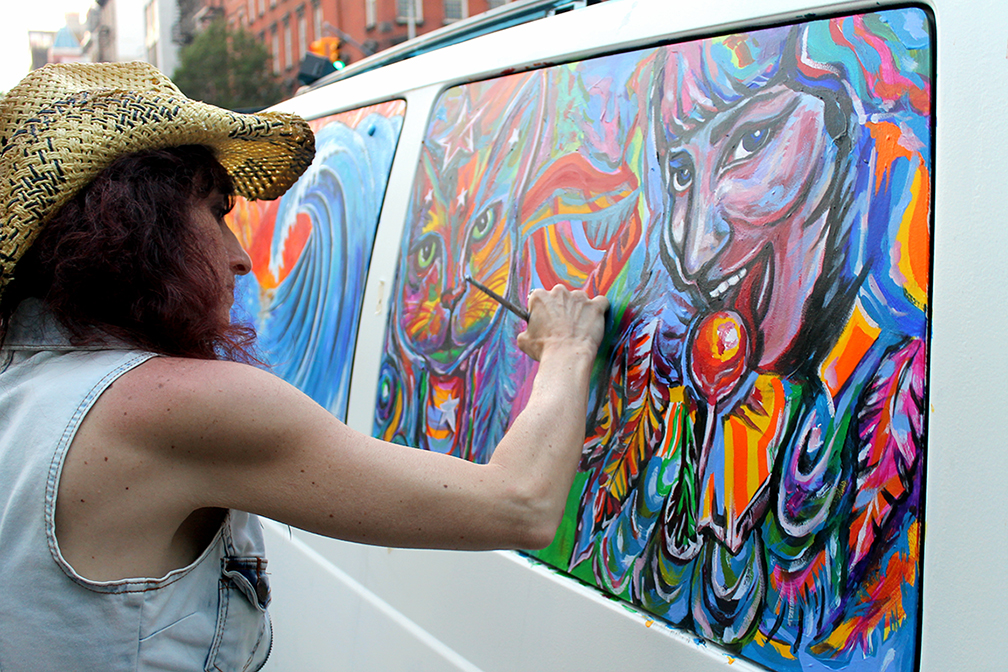
I had a chance to break away from the institution in 1998, when the spirited artist inside me fought to stay alive. I removed myself from the meds, flew out to Colorado, spent time taking Ukrainian and West African dance classes, and pursued painting and theater again, all within the sanctity of nature. But when my setting changed back to the nerve-wracking grip of New York, things shifted badly. I was opening doorways in my mind in time and space, alternating between this world and another, but unable to return home to “objective reality.” Madness had taken hold again, and I slipped into what the institution classifies as psychosis. And once more, I was to do my time at St. Vincent’s Hospital four years after my first visit.
Many bipolar people experience this wakeful dream state—a mental realm where the dream world crosses over into reality, which is similar to what a shaman experiences inside his journey. Being in two realities at once allows the shaman to merge with dream time, the place where inspiration sits and holds the only truth that can be trusted. Its terrain is one of symbolism, containing images that hold special meaning or allegorical significance, like that of a dream. The symbols contained within a wakeful dream state are entirely disregarded in psychiatric diagnosis and treatment, and yet they reveal the real story beneath strange outward behaviors. In indigenous cultures, novice shamans are guided by experienced masters and are taught how to navigate their way on the other side and safely return back from their journeys so that madness does not manifest in their psyches. But in Western psychiatric medicine, “psychosis” is always the worst possible pathological symptom, whether or not it’s violent, whether it’s enlightening or debilitating. A disconnect with the “way it is” does not open up a conversation, but instead slams the door in the faces of those who depend on their imaginations to help them interpret their reality, as we artists do, in order to survive.
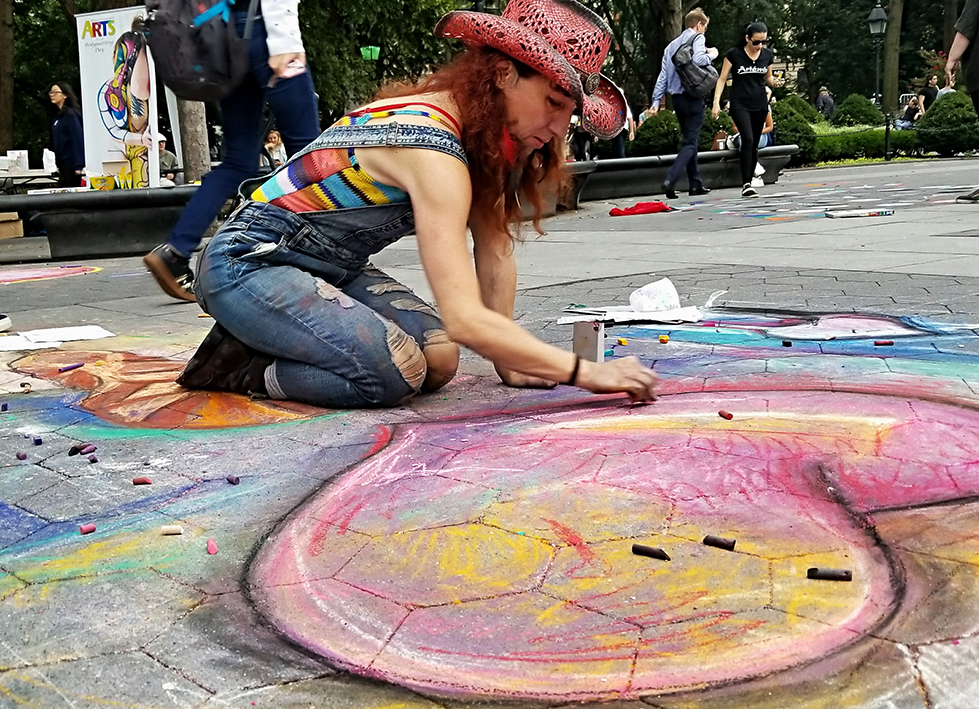
After a rigorous two-week reconditioning in Inpatient with another two weeks of brainwashing in Outpatient, my discharge records noted that my mood was stable, and I was functioning “much, much better.” My affect was appropriate and “of full range.” My thoughts were logical and coherent, with no “flights of ideas” or racing thoughts; my speech was at a normal rate, volume, and quantity. My behavior was totally under neurological control, and thus I was “normal” enough to return to my life. Once again, I had no choice but to comply with their treatment program because I could not explain what was happening to me.
I had a good run for eight years. I attained my master’s, became a teacher, and married a man who fell in love with me despite my label. But in 2005 when I told my doctors I wished to get pregnant, each one of them discouraged me from motherhood with the same pressing tone that if they should allow me to pass on my bipolar gene to the next generation, they were violating the Hippocratic Oath. I was on the mind-numbing anticonvulsant Depakote, which was known to cause birth defects, and so my psychiatrist, Susan Weston at St. Vincent’s Hospital, referred me to the Perinatal and Reproductive Psychiatry Clinical Research Program at Harvard’s Medical School at Massachusetts General Hospital to discuss my options. It was the only institution at the time that had conducted research on the birth defects linked to psychiatric meds taken by bipolar women during their pregnancy. I drove all the way to Boston to be told by Joffe Hadine, Instructor of Psychiatry and Director of Endocrine Studies (who happened to be in her third trimester), that I had only two available choices: Do not have children, or take lithium while I was pregnant—the drug that posed the least amount of birth defects, and conveniently, the very medication that had killed the painter in me years ago. I refused both options and set out on my own, and luckily found a willing psychiatrist to help me taper off the meds so that I could safely conceive, and by the winter of 2006, I was meds free.
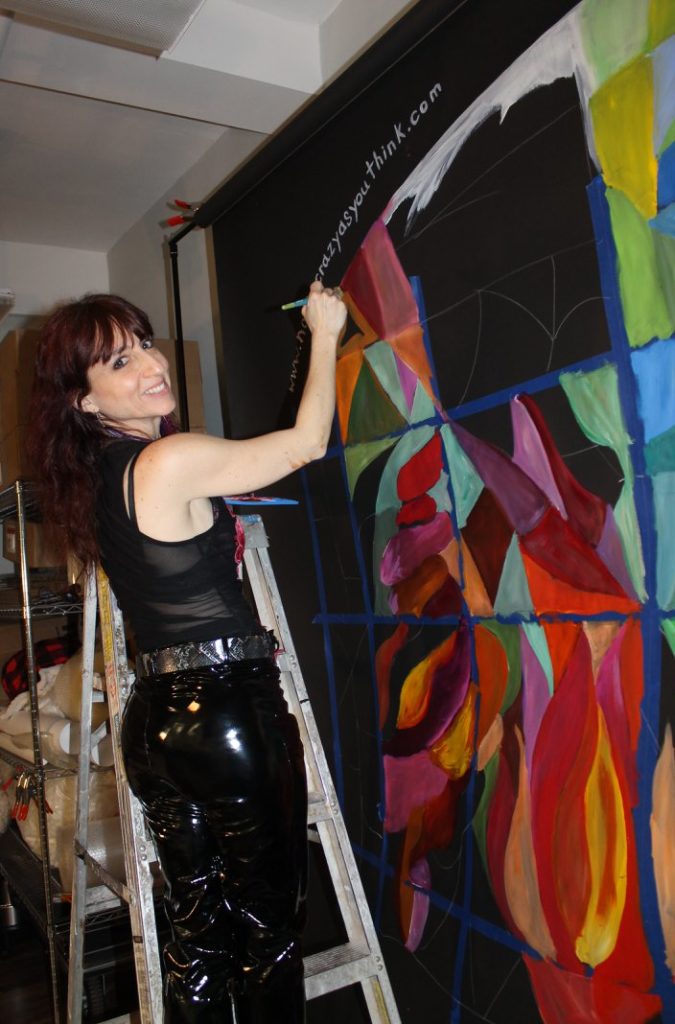
Then, everything gained such fast momentum. I was teaching a full course load of six different English classes, and was also directing late-night rehearsals in the final weeks of our musical theater production. I needed a break from it all, and I needed to give attention to my personal artistic projects during this mid-winter vacation. My desire to explode into my creative process screamed a symphony of cries. This artistic madness driving forward was sure not to last forever, so I had to move as quickly as possible. Through cutting, pasting and collaging, I worked for days collecting bits and pieces of symbolism in order to tell my story. But I got lost in my shamanic journey once again and couldn’t find my way back home. I was to endure my third commitment, this time at Four Winds Hospital in Katonah, New York.
Grace had blessed me. The trial in getting off the meds was worth it. The blood test showed I was pregnant, which meant I couldn’t take anti-manic meds. I journeyed in the wakeful dream state for what felt like an eternity. Roaming in my imagination, acting out one ritual after another, one epic dream flowing into the next, entertaining the staff and the inmates alike, all throughout the long days and nights, and on the 10th night, I finally snapped out of my mania. When I tried to fly out of my white birdcage in the spirit of a horse, I slammed myself into the locked exit door. The late-night nurse staff tackled me to the floor in the hallway and plummeted a shot of Thorazine into my ass. And after a good night’s sleep, I returned to the normal real world of the living dead.
I managed to mask my “abnormal” ways and have a real life for six years. I had the joy of raising my son—the one who should not have been, my doctors would say. For him, I left my stifling teaching career and committed to my development as an artist. But over the course of time, the lines between normal and abnormal no longer existed. My past psychiatric history had caught up to my present, and I no longer needed to be in a wakeful dream state to be assigned aggressive treatment by the psychiatric institution. In 2012, I was committed again to Four Winds Hospital because I couldn’t sleep through the roar of New York’s Hurricane Sandy, and my parents were concerned. Upon this stay I knew for sure. Psychiatry had no true measure in differentiating sane from insane because upon my admittance to the hospital I was completely lucid and not at all in any state of psychosis. And within one day of taking the sleeping pills dispensed to me, I was fine to return to my life at home; but my good insurance provided the funds for a 10-day stay, while suicidal inpatients who came in after me were free to go before me.
Many were in that week because the turbulence of Hurricane Sandy barraged their psyches. It was the end-of-the-world year of 2012, during the voting of Obama’s second election, and the empaths inside sensed the truth about the quietness of it all. We were aware that these labels had silenced our voices forever in our own country. All our votes were lost that year—the dissidents, the artists, the dreamers, the ones who saw more than everyone else who was plugged in. Yet there was no other way for us to be seen or heard except through our labels. There are no laws that protect the freedoms of the “mentally ill.” Whether or not we showed ourselves to be dangerous, our labels suggested the possibility of us acting out, and that was enough for them.
I realized that in this lifetime, I could never truly be free. My entire identity had been stolen from me. They never saw me for who I was—a smart, talented and gifted individual—but as an abnormal bipolar mental case with a history of psychosis.
My most hostile imprisonment yet took place on St. Patty’s Day 2017 at Northern Westchester Hospital in Mount Kisco, NY. At the admission interview, I pleaded with Dr. Katherine Harding (the psychiatrist who after looking up my DSM pharma code immediately secured for me a bed in their psychiatric unit upstairs with no further questions asked) to explain to me why I needed to stay:
“But what do you have on me? Do you need to see my resume to see that I am a successful woman in my field, that I am a contributing member of my community? You know nothing about me so how can you make decisions regarding my life? I have proven myself in my art career and in my success with professional relationships and dear friends on every level. Doesn’t that factor in? Do I need to bring every one of my friends in here to vouch for my character? I want to know, what is the purpose of this? I am a grown 45-year-old woman. My parents can’t put me away in your prison camp for no good reason. What is the reason? I want to speak to another person. I want my voice to be heard!”
She answered bluntly, “Your parents are concerned.”
It didn’t matter how successful I had become or how happy and well-balanced. The psychiatric institution had convinced my poor parents decades ago that I could “relapse” at any given moment, and that they should watch diligently for any “abnormal” activities, wants, and drives so they could prevent future episodes through early detection. But these markers are vague, subjective and judgmental, and my creative processes, which can appear bizarre to others, are natural and normal for me as an artist. And there is no way I can shed the core of what makes me who I am because it’s in my God-given DNA.
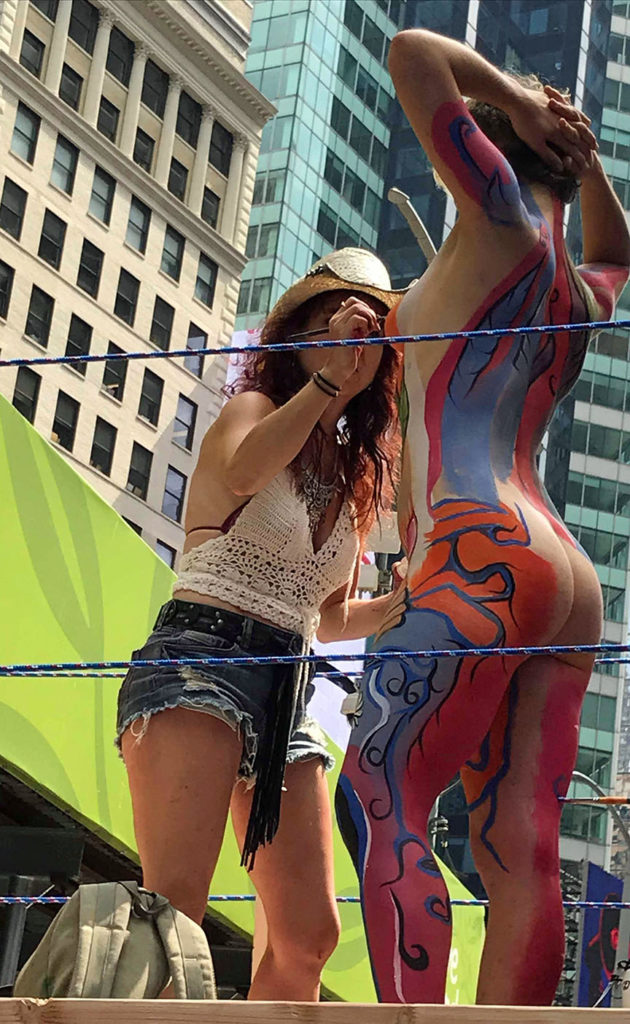
To this day, I live in danger of being misunderstood and given involuntary commitment at any time in my future because the psychiatric institution no longer needs reasons for their actions taken against me other than having the tag of “bipolar disorder” attached to my medical record. During both Hurricane Sandy in 2012 and St. Patty’s Day in 2017, no matter how compliant I was, I still couldn’t convince them I was “well” or “normal” enough to get released earlier than 10 days. Because that is the standard length of time hospitalization will be covered under most insurance companies for people labeled with bipolar disorder. As a result of this label pinned to my name decades ago, I have never been discharged in less than 10 days. Over the course of my lifetime my commitments earned hospitals almost $250,000 from insurance companies for my tragic “medical condition.”
Today, I am fighting the institution on my own terms. I have blossomed into the promising artist I was born to be, and for over a decade I have recorded in my memoir the unethical abuse I have endured my entire adult life with the hope that one day I will gain back my freedom. But the raw truth is, I am up against a monster of power that has no interest in giving up its rule anytime soon. As a bipolar artist determined to survive, with no freedom left to my name and with nothing left to lose, I must hold onto my faith that it’s worth the fight.


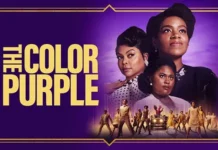












As someone labeled Bipolar 2 I believe all my “manic symptoms” were iatrogenically created by shrinks. I started out depressed and anxious. They helped by causing full blown psychotic mania with drugs like Anafranil.
They said i would need a bunch of drugs forever. That my reaction to Anafranil proved I was “defective” and I deserved a life of agony/premature death as punishment.
Got off their neuro-poisons. No more mood swings. My family is amazed. We realize now that mainstream shrinks are full of it. 😛
Full of themselves. Which is kind of the same thing. 😀
Report comment
Rachel,
I’m so glad your parents finally puked up the kool-aid. I remember when you feared they never would. You were very smart to taper off the poisons without anyone being the wiser, and only sprung it on them after you’d been clean long enough for them, to remark on your vast improvement.
Report comment
Mom admitted it was smart to conceal it from her til after the fact. She acknowledged she would have worried too much.
Report comment
Jennifer, thank you. Keep up the fight. You are winning.
As I’m sure that you are well aware by this point, there is really no such thing as “bipolar disorder,” and psychiatry is a sham. Psychiatry is a pseudo-scientific system of slavery that masquerades as a medical profession. It is simply criminal what psychiatrists have done to you, and what they are doing to millions of innocent people, including children, the homeless, and the elderly.
I believe that your artistic talents will flourish now more than ever, and that you will be able to help many other people who are suffering as a result of psychiatric abuse. Along the way, if you are looking for some good reading on the topic, I highly recommend the work of Thomas Szasz, Peter Breggin, and Robert Whitaker.
Keep up the good fight, and all the best. – DS
Report comment
So it sounds then that you go along with the idea of ~mental illness~ and do not think that survivors should rally together to protect each other, and the next generation, and plow the mental health system under.
Report comment
Woooh! This woman’s biggest problem wasn’t even #FAKESCIENCE . It was those Munchausen parents, who used psychiatry as a means to “parent” Jennifer forever. They, clearly, resented their duty to respect her as an adult, and offer her the sort of support that one provides an adult: domestic care (caring for grandkids, cooking meals, pep talks for overwhelmed spouses, etc.) and strategies (tips on setting schedules, fending off unreasonable demands, etc.) for balancing their day job, their family, and their lofty professional goals. So, whenever Jennifer’s life became a life-sucking trap, they quacked her out of it, instead of helping her stay in it, and fix it up. Jennifer need to quit psychiatry, for sure. But, in order to achieve that, she’ll probably have to quit her parents, too. Were it not their possessiveness, she’d easily have ditched psychiatry a decade ago.
Report comment
I, too, am an artist who was mislabeled as “bipolar,” due to a misdiagnosis of the common symptoms of antidepressant discontinuation syndrome, as “bipolar.” It’s a shame our psychiatrists are too stupid to even read their DSM-IV-TR.
“Note: Manic-like episodes that are clearly caused by somatic antidepressant treatment (e.g., medication, electroconvulsive therapy, light therapy) should not count toward a diagnosis of Bipolar I Disorder.”
The “mental health” workers do like to attack and control the artists though. Especially those of us whose work is “too truthful,” “insightful,” and “prophetic.” My former psychiatrist, once he finally saw my work, overcame his delusions that I was “w/o work,” and claimed my work to be “insightful,” because he assumed my story would mesh with his DSM deluded belief system. And he weaned me off the drugs.
But, when the truth is attached to my work, the truth about the malpractice I’d previously dealt with, and the reasons for that malpractice – to cover up the abuse of my children by a pastor and his best friends – oops! My work becomes “too truthful” and “prophetic” for the child abuse covering up “mental health” workers and my child abuse covering up former religion.
The child abuse covering up criminals want me to live their lie, but I’m not interested in living a lie. I did get an ethical doctor to take the “bipolar” misdiagnosis off my medical records, however, by explaining the malpractice to him. He was intelligent enough to understand that antipsychotic induced anticholinergic toxidrome (which creates “psychosis” and “hallucinations”) is not “bipolar.” This might work for you as well?
Keep up the good fight, and wonderfully creative work. I’m working on a piece right now depicting my “Great Escape from the Unmentioned War Within, Psychiatry’s War Against the Innocents.” It’s inspired by a Chagall piece simply named “War.” The psychiatric industry is repeating the worst of history, unfortunately, with their modern day psychiatric holocaust.
https://www.naturalnews.com/049860_psych_drugs_medical_holocaust_Big_Pharma.html
Report comment
You wrote “my poor parents decades ago that I could “relapse” at any given moment”.
This is an exploitation of fear ( of the future) in the parents, that psychiatry is happy to use. Your child is sick and must be helped. A parents love and need to keep the child safe. How does the child escape the parents and the psychiatrists fear of the future?
The psychiatrist can play the hero by drugging the patient so they can not perform any action, good or bad.
You causing any trouble?
Report comment
My parents–and others–were frustrated at the profound malaise I showed. Laziness they called it. But they wondered why the “meds” didn’t fix it.
Most “NAMI mommies” are themselves hapless victims drawn in and deceived by those frauds called psychiatrists.
They wonder why their adult kids become less able to care for themselves the more “treatment” they receive. Often they wind up burying the offspring they truly wanted to help lead an independent, quality life. 🙁
I can’t post links here, but on BeyondMeds.com archives Monica addresses how NAMI deceives everybody. Including family members who believe they’re helping.
They’re merely misguided. It’s the well-informed liars, with no compassion or moral compass, who deserve the blame.
Report comment
I LOVE your art! Wow, absolutely amazing! Thank goodness you aren’t on those drugs anymore!
I was also called bipolar, only for convenience. The shrinks’ convenience.
What if you dropped all contact with your parents? While I realize it’s a sacrifice, they aren’t helping, are they?
By the way, I know Dr. Joffe. My doctor, Dr. Kimberly Pearson, worked with her. Pearson would have said the same thing, told you to stay on the drugs. Or given you more.
Report comment
Jennifer maybe you should relocate. You aren’t dependent on your parents. I’m not sure why they were concerned. Because you were “too” exuberant I guess.
If you were paying your bills and all the stuff adults are supposed to do they were misguided to even worry. Let alone have you locked up.
Report comment
You are not a “bipolar artist.” You are an excellent artist.
Just stay the hell away from these snake oil peddlers, don’t try to “convince” them of your sanity. To what end? You’re already on a higher level, obviously.
Report comment